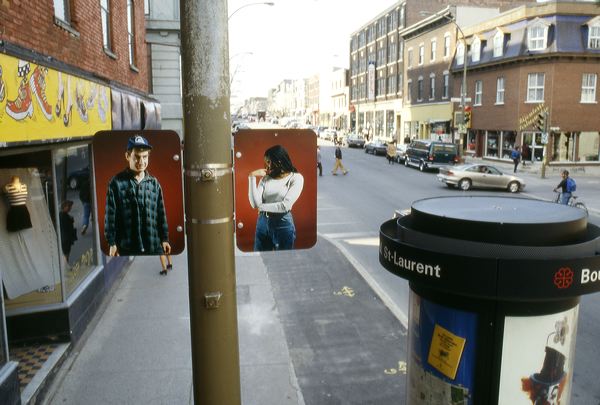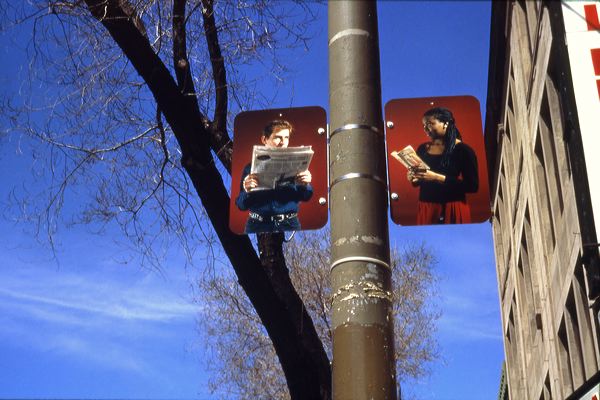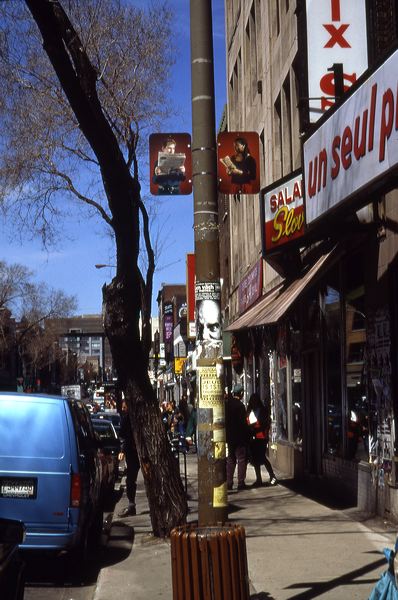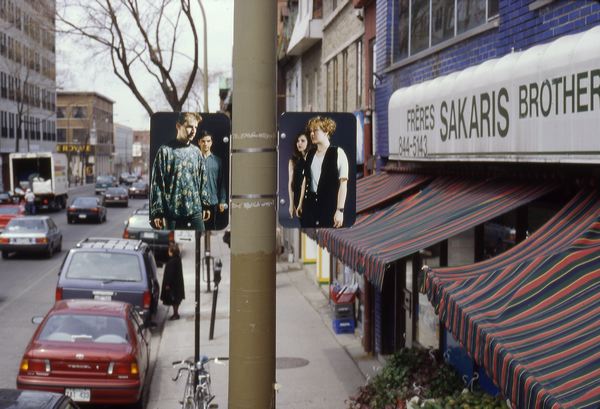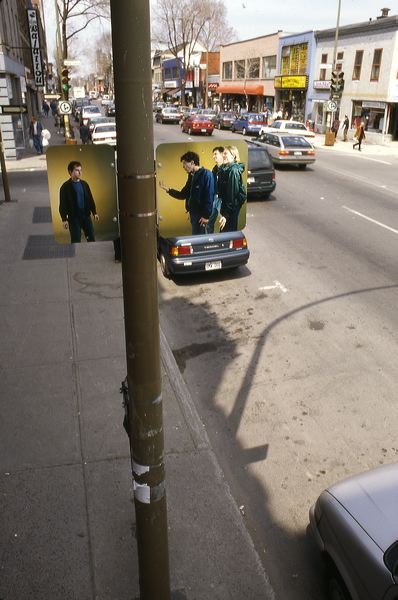HESITATION
May 4 - June 1, 1996
Street Installation of traffic sign photographs on Boulevard St. Laurent, Montréal
Exhibited with the assistance of Galerie B-312, Montreal

Text by Kevin deForest
As has been the tendency in critical debate around the
place of the artist in the reclamation of 'public' cultural space,
Paul Litherland's 'Hesitation' has taken to the streets, activating
the social relations of everyday as a space of self empowerment and
contention. The chosen
site of intervention, St. Laurent Boulevard, between Sherbrooke and
St. Viateur streets, is still one of Montréal's
most diverse intercultural free zones. Taking the 55 bus up the Main
is often an event in itself, as Portuguese babas, techno teens, and
thirty something allophone Plateauites merge on their climb upward
through Chinatown, upscale and dollar store shopping, Little Italy
and Hassidic Outremont (to name a few variables). Despite its function
as a major traffic artery, it is pedestrian privileged. Cars pass
cautiously through this zone of the unexpected, of casual urban sidewalk
culture, where outrageous and conventional dress codes collide and
mutate in mutual eye contact. Geographically, it also serves as the
dividing line between anglophone west and francophone east, important
border territory in the mapping of Québecois identity. To produce a 'public' artwork is to engage simultaneously in constructing a model of a utopian society as well as providing a critique of that idealistic notion. Transforming through the counterculture strategies of Marxist theory of the sixties and seventies, in particular the workings of the French situationists and Conceptual art, the term 'public art' implies a call and response to the very idea of representing an ideology of community. The diversity of voices within a current condition of cultural Diaspora makes it a complex endeavour to somehow provide points of access or communion. Paul Litherland's "Hesitation" activates
the urban visual fabric of identity by the installation of photographs
on light posts through the Main. Mounted to metal backings, they
resemble traffic signs in their scale and the shape of their
rounded off edges. A graphic clarity is maintained by the simple
format of the imagery - figures from the ankles up posed in front
of monochrome backdrops. But unlike the crosswalk 'marching man'
found at pedestrian crossings, the subjective, funky presence
of identities and social situations counter the state provided
sign system, and their design of transparent order and protection. As figuration, these images provide a body language that suggests, or attempts to represent the activity of social interaction. Clearly staged and studio lit, they appear as reconstructions of the banal. This dramatization of the everyday is not linked self consciously to art historical references. Instead, they are reminiscent of pedagogical ad campaigns around the combating of social ills such as drug abuse. The target group of 'Hesitation' appears to be the teen or young adult, caught in a crucial stage of identity formation towards becoming a 'responsible citizen'. Litherland, however, is not one to moralize, nor to overcome the poltergeist of adolescence. The dramatic struggles or confrontations acted out by his 'kids' remain non-directed and unresolved. The ambiguity of these social relations and Litherland's
resistance to taking a prescriptive or accusatory stance in a more
explicit manner (such as the work of political activist groups
such as Act Up or Guerrilla Girls) points to a concern towards
imagining and providing a sense of empowerment through communality.
Through its lack of a clearly illustrative reading, it allows a
space in the work for the viewer to enter and in turn question
his/her own subjectivity. Further, it acknowledges the location
of the art object as being paramount to its meaning, and its potential
for social change. Clearly, the response towards an image of two
men embracing would connote a different meaning and impact depending
on which neighbourhood it were placed in. By proposing social solutions
in his imagery but leaving their resolution incomplete, this work
creates a generous space for the viewer to enter and reflect on
their own subjective notions of identity and community. And what of Litherland's own visual identification in the imagery as a white male? This work, in its self interrogation, begins to provide an alternative representation to that of the overly reductive oppressor. What is evident in the work is an empathy towards counter-hegemonic strategies and approaches. The exploration of the taboos and faults of his heritage as a 'colonizer' is not meant to arouse sympathy for his situation, nor to invalidate the arguments for those oppressed by the values handed down by the traditions of the white male status quo. What it does acknowledge however, is that there are alternative, groupings under the blanket grouping of white male, that an empathy with oppression can still cross the boundaries of difference. By including his own image in these photos, and representing
scenes of conflict, desire and awkwardness, Litherland's work turns
ultimately inward. As a self-help, self-investigative art making
practice, he provides a role model of himself, for himself. The
works' public setting further acknowledges his identity or authorship
as being determined in part by his reading audience, as passers-by
engage and interpret these idiosyncratic sign systems. A loud flowered
shirt for example, or the presence of a young woman peering mischievously
from behind a copy of Virginia Woolf's Orlando, provides more than
a simple illustrative argument around identity. They somehow bring
a moment of everyday into view, mapping a personal geography in
the public realm and at the same time acknowledging a quirky and
vulnerable state of living. Kevin deForest |
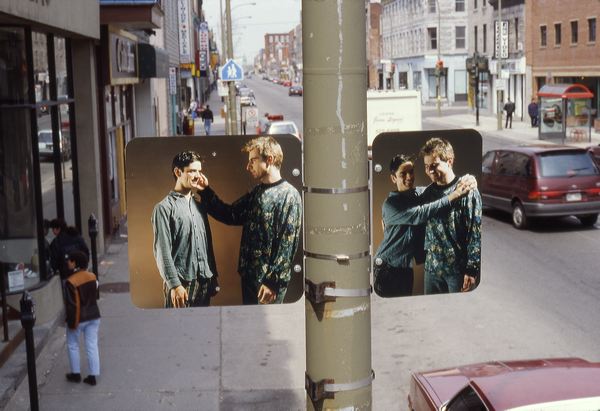 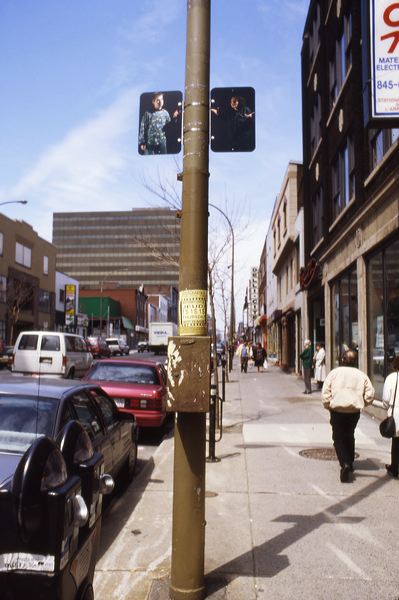 |
